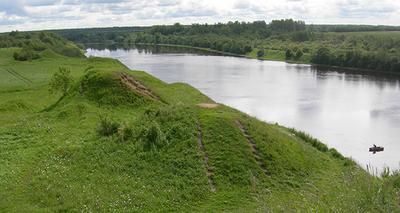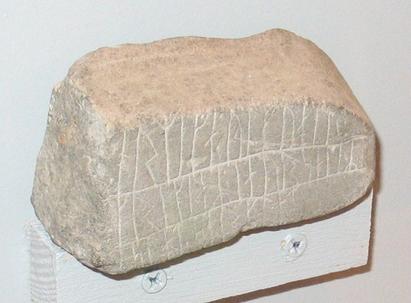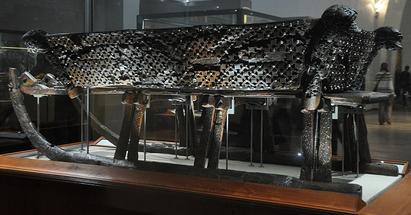Dangerous journeys to Eastern Europe and Russia

The ships used by the Vikings were vitally important to their trading and enabled them to reach far-flung destinations. The Swedish Vikings in particular travelled eastwards. From the trading town of Birka and from Gotland they sailed across the Baltic, then along the East European and Russian rivers, reaching as far as the Black Sea and the Caspian Sea. Along the rivers they stopped at trading centres and towns, and thus came into contact with a trade network stretching as far as India and China.
However, such a journey was extremely risky, not least because the Vikings had to pass through territories inhabited by numerous different foreign peoples. Here they faced the risk of attack and robbery. The journeys were made even more dangerous by the fact that parts of the Russian landscape were impassable, and its rivers contained shallow areas and rapids. Therefore the Vikings relied greatly upon the knowledge of the local inhabitants.
The journey to Kievan Rus
At the end of the 8th century the first Viking ships reached Kievan Rus, which was the name of the Russian state at this time.
The town of Staraya Ladoga was the Vikings’ access point to Kievan Rus. Visitors to the town today can still see the Viking burial mounds along the Volkhov River.
The trading town of Ladago emerged at the end of the 700s. It had much in common with, for example, Hedeby and Birka, but was also used as a “lay-by” where traders with goods could wait for suitable weather to continue their journeys.

The Caliphate in Baghdad – Særkland
The Arabic empire was also an important destination for the Vikings and they called the empire Særkland, “the Silk land”. The route to this destination involved travelling to the east via the Volga River. Along the way Bolghar was an important international market centre, as it was the westernmost destination of the silk merchants, who came all the way from China in their caravans. The Vikings also encountered the large quantities of Arabic silver at Bolghar.
Silver was of great significance to the Viking economy. Many of the Viking Age silver coins that have been found in Denmark were struck in the Arabic Caliphate, in the modern-day towns of Samarkand and Tashkent. Large and important silver mines were located in this area. However, after a period of time these mines were exhausted and Viking interest in the eastern trading routes waned. This occurred at the end of the 900s. The Viking demand for silver was subsequently satisfied in Central Europe, in particular by the silver mines in the Harz Mountains.
Finds of imported products originating from the eastern trade networks are not particularly common in Denmark, with the exception of Arabic silver. This is possibly because certain types of imported products from the Viking period are unlikely to survive until today. Silk and embroidery, for instance, are only very rarely found intact.
Byzantium – “the great city”

An important reason why the Vikings travelled eastwards, was their desire to establish trading connections with the Byzantine Empire. Its capital Constantinople – today’s Istanbul – was the trading centre for goods from the whole of the Mediterranean region, North Africa and the Near East.
Here Vikings could buy exotic products such as silk, embroidered cloth, wine, fruit, spices, as well as semi-precious stones like carnelian and quartz. There was demand for these goods in the Scandinavian market. The long and difficult transport routes made them even more valuable when they finally reached the trading towns of Birka, Kaupang and Hedeby.
The Vikings called Constantinople Miklagård, “the great city”. It had an elaborate system of defensive walls, impressive churches and stone buildings, which took the visitor’s breath away. In comparison to Constantinople, Hedeby and the other Scandinavian towns must have seemed unimpressive.
By ship or sledge along the Russian rivers?

Recent research has shown that the sailing of Viking ships on Russian rivers should only be undertaken by experienced sailors. A group of Swedish researchers made a summer voyage from the Mälaren Valley in Sweden to Novgorod in Russia in a clinker-built vessel, which was 9 metres long and constructed like a Viking ship. Even though the crew had considerable experience in sailing the vessel, the journey took 42 days. They then travelled on from Novgorod to the mouth of the Dnieper. The journey to this location took 89 days, in other words three months. In addition, for over 250 km of the trip the boat had to be dragged over land.
The conclusion must therefore be that a boat trip from Central Sweden to the Black Sea and back could not have been completed before the Russian rivers began to freeze over again. Every journey by ship beyond Staraya Ladoga must therefore have involved staying for at least one Russian winter.
An alternative to summer sailing was winter transportation using horse-drawn sledges. The Vikings could use sledges on the frozen rivers to reduce the journey time from months to a few weeks. Recent Russian research shows that up to 150 km a day can be covered travelling by sledge. This means that a journey from Novgorod to Gnezdovo by sledge could have been made in 7-10 days, whilst a boat journey took around 30 days. Sledges obviously transported smaller loads than boats, but their use could also save a great deal of time.
Numerous finds of sledges have been made in Russia, especially in Novgorod, where most date to the later Viking period. Sledges from as early as the late 8th century have been found at Staraya Ladoga. These dates fit in with the distribution of other Viking objects found along the Russian rivers.
Evidence of winter transport has also been provided by finds of crampons, which were used by travellers and on horses. Crampons are small iron knobs that are attached to shoes or horseshoes to give a more secure footing on ice and snow. They were present in a burial containing two horse skeletons from Staraya Ladoga. Both animals had been shod with horseshoes which had crampons attached.
